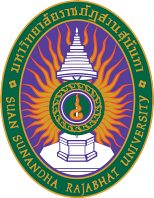Community Participation in Arts and Culture Learning Resource Development: Case Study of Communities along Chanthabun Riverside
DOI:
https://doi.org/10.53848/irdssru.v8i2.214432Keywords:
participation, arts and culture learning resources, communities along Chanthabun RiversideAbstract
This study aims to investigate community participation in arts and culture learningresources development and to analyze the impacts of such development on the community.The research was conducted by qualitative study methodology. Data collecting tools includedinterview form, observation form and group discussion. Through purposive sampling, the samplegroup consisted of community committee, interested persons having direct experiences withcommunity development for more than 5 years while by applying accidental sampling, anothersample group included community members and visitors using learning resources for totaling100 subjects. Triangulation technique was applied to evaluate data credibility. The study resultswere presented indescriptive analysis. Findings from the research suggest that the communitymembers provided cooperation in carrying out activities for arts and culture learning resources
development. The operation could be divided into 4 phases as follows: 1) take part in selfidentificationand the approaches for community development in order to find out strong point
and best model for development that could bring about positive attitude among communitymembers and interested person. 2) determine development plan and communicate it to the community in order to jointly develop community vision and missions, organize activitiesencouraging participation, gather community data, coordinate with cooperation network and
public relations aimed to set up community museum that can result in positive impact on community interpersonal relationship 3) communicate to establish understanding and participation in physical development in order to allow the community to seek for the approaches for building conservation and physical development. The possible impact at this stage included preventing certain groups of community member due to inefficient communication in some communities 4) support participation in community commercial activities of the community and by the community resulting in better economic situation in that given community and community business jointly owned by community members. Through the above community participation, it could achieve its targets.
References
Cultural Impacts of Tourism
Developmemt in Chiangrai
Province, Thailand .Bangkok : The
development and Tourism in a
sustainabla Fashion Fund Support
Reseact office.
Seri Phongphit. (2007). Life Plan and
Community Economy. (5thedition).
Bangkok: Wisdom Power.
Thip Sisakulchairak. ( 2016). Muang
Chanthaburi : Original Model of
Community Economy by
SocialActivities PathumThani:
Metropolitan and City Study Center
Rangsit University in cooperation
with Public Wisdom Institute
(CPWI).
Downloads
Published
How to Cite
Issue
Section
License
บทความที่ได้รับการตีพิมพ์เป็นลิขสิทธิ์ของ สถาบันวิจัยและพัฒนา มหาวิทยาลัยราชภัฎสวนสุนันทา
ข้อความที่ปรากฏในบทความแต่ละเรื่องในวารสารวิชาการเล่มนี้เป็นความคิดเห็นส่วนตัวของผู้เขียนแต่ละท่านไม่เกี่ยวข้องกับมหาวิทยาลัยราชภัฎสวนสุนันทา และคณาจารย์ท่านอื่นๆในมหาวิทยาลัยฯ แต่อย่างใด ความรับผิดชอบองค์ประกอบทั้งหมดของบทความแต่ละเรื่องเป็นของผู้เขียนแต่ละท่าน หากมีความผิดพลาดใดๆ ผู้เขียนแต่ละท่านจะรับผิดชอบบทความของตนเองแต่ผู้เดียว





